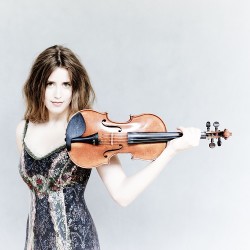 United Kingdom Mozart: Vilde Frang (violin) Lawrence Power (viola), Oxford Philharmonic Orchestra / Marios Papadopoulos (conductor). Sheldonian Theatre, Oxford, 9.2.2019. (CR)
United Kingdom Mozart: Vilde Frang (violin) Lawrence Power (viola), Oxford Philharmonic Orchestra / Marios Papadopoulos (conductor). Sheldonian Theatre, Oxford, 9.2.2019. (CR)

Mozart – Symphony No.35 in D major, K385, ‘Haffner’; Sinfonia Concertante in E-flat major, K364; Symphony No.41 in C major, K551, ‘Jupiter’
In this all-Mozart programme the Oxford Philharmonic Orchestra were on generally fine form, creating the sense of effortless flow that is a hallmark of that composer’s style. Marios Papadopoulos led them off with a spirited account of the ‘Haffner’ Symphony, the antiphonal placing of the violins helping to draw out its theatrical nature with different melodic lines passed back and forth between them, or drawing attention to the ticking quavers which underlie the first violins’ opening in the second movement. It was pity that the lyrical, vocal quality of the latter was marred, as in other places in this concert, by some less than unanimous playing from the firsts, which made the music sound scrappy. Otherwise the movements of the Symphony were well contrasted, with a stately Menuetto set around its playful Trio section, and a dramatic interpretation of the finale with bold gradations in dynamics.
The OPO offered a lithe texture for the Sinfonia Concertante, perhaps belying the warmly mellow tone which the choice of the key of E-flat major often drew from Mozart, as here, and perhaps not quite attaining the ‘maestoso’ direction of the first movement’s heading. However, on the solo viola, Lawrence Power tended to accompany the orchestra in the tutti sections, helping to bring out the rich inner part-writing of Mozart’s composition. His and Vilde Frang’s first solo entry together was coy, but afterwards they were more forthcoming, especially Power with his somewhat more buoyant contribution. Frang remained more reserved although she projected her part on the violin with authority, and together the two soloists’ lines fused mellifluously in the magical second movement, sustained by the warmly veiled support of the OPO underneath, carefully controlled by Papadopoulos so as not to become cloying.
The Presto finale rightly fizzed along, the music’s skittish quality emerging from the vivid interplay of dynamics, here drawing back to a tantalising piano or pianissimo, there thrusting itself back into full view. Over that, Frang and Power’s dialogue remained a more consistent musical presence, not necessarily carrying more substance in the music’s argument than the orchestra, but constituting a merely different and more immediate plane in the multi-layered score. They continued the high jinks with a short but madcap set of variations on the melody which Mozart knew as ‘Ah vous dirai-je, Maman’ (as witness his own keyboard variations, K265) and we know better today as ‘Twinkle, Twinkle, Little Star’.
Papadopoulos’s interpretation of Mozart’s final symphonic masterpiece, the ‘Jupiter’, was broad and portentous. In one sense the work’s ambitions demand that, but it also tended to preclude the urgency and alacrity which the music needs. The first movement was more moderato than vivace; the Menuetto cautious at first and then stately without quite taking off with the lilt of the triple-time dance that it should; and the fugal finale was treated with too much over-awed heftiness from the start so that the intricacy of the contrapuntal lines were hectically pummelled rather than teased out, and the zealous attack to begin left little room for a more assertive climax late on. If the hard sticks on the timpani became wearing by the time of the finale, that timbre nevertheless provided zest, and in other respects the OPO offered a distinguished and balanced characterisation of Mozart’s ever-fresh music.
Curtis Rogers
